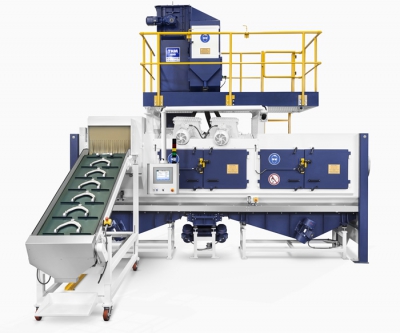
Walther Trowal offers a new generation of blast turbines for the troughed-belt, continuous-feed shot blast machines, type THM. These turbines increase the throwing speed and, thus, reduce cycle times for shot blasting of light metals like aluminum and magnesium. For weight reasons, these two metals are increasingly replacing components, which to date were made from steel. However, shot blast applications for aluminum and magnesium frequently require soft, less abrasive blast media like aluminum shot.
When it comes to shot blasting die castings or forged components made from aluminum and magnesium, but also zinc, many users are switching to somewhat softer aluminum blast media. Yet, because of their lower bulk density the impact energy of these media is significantly lower compared to other media like steel shot. For this reason, Walther Trowal developed turbines with curved throwing blades, which generate significantly higher throwing speeds.
In addition to higher throwing speeds, the new turbines also allow a much higher media throughput. Despite the lower media bulk weight of these “soft” blast media the results are shorter cycle times an, at the same time, greatly improved surface finishes.
Because the throwing blades in the new turbines are curved on both sides, the turbines can be run in two directions.
For applications requiring steel and stainless steel blast media, Walther Trowal offers the curved throwing blades in wear resistant tool steel. This increases the overall blade uptimes significantly.
The first machine equipped with the new turbines will be delivered to a customer shortly. Of course, existing THM machines can be easily equipped with the curved blade turbines allowing the users to increase productivity and reduce their costs.
The THM continuous troughed-belt machines can handle large quantities of bulk produced small parts, as well as large, delicate single workpieces with complex shapes. Because of the much simpler and gentler workpiece handling, they frequently replace conventional batch tumblast machines.
THM continuous-feed machines are especially advantageous for treating very delicate components: Contrary to batch tumblast systems, where the parts are intensively tumbling over each other with a high risk of nicking, in the Walther Trowal THM machines the workpieces are spread out throughout the length of the trough, ensuring a gentle, nick-free processing. The workpieces are gently rolling over the transport rods coated with polyurethane. This gentle part transport is especially important for complex, thin-walled components requiring an intensive blast cleaning process. The results are perfectly cleaned parts without any nicking or other damage, according to the company.
Compared to spinner hanger machines, the THM continuous shot-blast systems also offer significant technical advantages. Because the workpieces are gently tumbling through the tunnel formed by the troughed belt, they are exposed to the blast stream from all sides, with the distance between workpieces and turbines remaining constant. This ensures all around, perfect shot blasting results.
The blast cleaning and deflashing of die-cast or forged aluminum components requires soft blast media. Typical forged parts are steering knuckles or swivel bearings. Aluminum die castings processed in THM systems can be housings, covers, caps and levers.
But there is also an increasing trend towards utilizing magnesium die castings, especially in the automobile industry. Many structural components, for example dashboard mountings, are made from magnesium. This material has not only a low weight, but also offers high tensile strength.
For shot blasting of these materials in THM machines aluminum media is becoming quite popular. Because the distance between the blast turbines and the workpieces is very small, the shot blast process is highly effective, even though the blast media has a low bulk density.
Contact Details
Related Glossary Terms
- abrasive
abrasive
Substance used for grinding, honing, lapping, superfinishing and polishing. Examples include garnet, emery, corundum, silicon carbide, cubic boron nitride and diamond in various grit sizes.
- tensile strength
tensile strength
In tensile testing, the ratio of maximum load to original cross-sectional area. Also called ultimate strength. Compare with yield strength.






